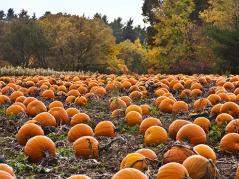Mar 21, 2018Time of pumpkin planting can improve success
Planting in late June provides approximately 100 growing days (maybe less, depending on where you are growing), which limits the varieties you can choose from, among which are newer varieties with various of tolerance to powdery mildew. It used to be that powdery mildew, and the eventual leaf collapse, fruit damage and rot associated with this disease, was inevitable, but these tolerant varieties, as well as stronger fungicides, make controlling this disease more manageable.
Besides limiting variety choices, pumpkin biology does not match well with later planting dates. When pumpkins are seeded in late June, plants invariably flower during a hot period in late July or early August. Not only do pumpkins not like the 90-plus degree weather, but neither do the pollinators responsible for fruit set. Flowers are not open very long under hot temperatures, and since pollinators are not as active, there is a high probability many flowers during this time will go unpollinated until the weather cools. This not only decreases fruit set potential, but also moves maturity even later for a late-planted field. Therefore, you run the risk of having many green fruit at harvest time.
Pumpkins should be planted as soon as the soil temperature in your area is adequate (65 degrees Fahrenheit). This is usually in late May or early June. This planting time will generally bring them into flower ahead of extreme summer heat, allowing flowers to set and fruit to grow rather than go unpollinated or abort. This does not mean you can forgo fungicide applications—pumpkins still need protection to control powdery and downy mildew. For 2018 fungicide recommendations, consult the “Midwest Vegetable Production Guide.”
If the leaves begin to collapse in September and the fruit are mature, go ahead and harvest and place them under shade. Once the fruit has matured (turned orange), it will not grow larger, so it is best to get them under protection to avoid sunburn and subsequent fruit rot.
Successful pumpkin production starts with choosing the right variety, planting it at the right time, protecting it from the various insect and disease threats and harvesting it at the proper time. All of these are under grower control. The only uncertain variable is weather and I am afraid controlling that is still away off.
– Ron Goldy, Michigan State University Extension















